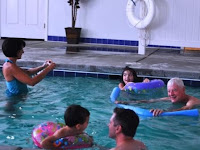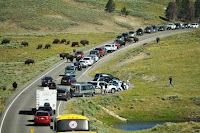After fourteen months of cruising North America, to Alaska though the Alaska Highway, to the Arctic Circle, down the West Coast to Mexico and across the Gulf States to the Keys and the Southeast, back west through parts of the Midwest and now up the Northwest, living in 23 American states, 3 Canadian provinces, and 4 Mexican states, we are finally coming ‘home’ to Seattle, Washington. Although it is now only a mailing address, Seattle seems home to us with friends, family, tenants, doctors and agents there.
From Boise, Idaho, we crossed the Blue Mountains, reached Southeastern Washington, and settled in Moses Lake, the largest city (pop: 18T) in Grant County, the potato capital of the country (despite Idaho’s claim!) . Its Saturday Farmer’s Market was spectacular ($1 large watermelons)! From there, we toured the Grand Coulee Dam near Electric City, the Hanford Reach National Monument near Othello, and the Gingko Petrified State Forest near Quincy, and the county’s the orchards, gardens, and nurseries.
Grand Coulee Dam is currently the largest dam in North America and the fourth largest in the world, behind Three Gorges in China, Itapúa in Brazil, and Guri in Argentina. Under construction in Canada, however, is Syncrude Tailings which will become the largest when completed and, along with a few others, will soon greatly change the rankings. Nevertheless, Grand Coulee is grand, especially with the laser light show in the evening (headline photo above), with the dam as the screen, telling its story.
The unusual topography of Eastern Washington was debated for a long time but is now widely believed to be the result of massive Ice floods from Lake Missoula in Montana. Created by huge glacier fingers from Canada first acting as dams and then giving way, in repeated waves, about 12-15,000 years ago, Lake Missoula is believed to have carried 520 million cubic miles of water (Lakes Ontario and Erie combined). Imagine the power of the water that rushed through the area, finding its way to the Ocean in just 3 days!
 The coulees that were formed are unique in the world and on the biggest of them all, the US under FDR invested Fed funds in building, during the Depression, the largest dam in America. On the way to the dam are interesting sidelights of the flood. From Moses Lake, you will pass through Soap Lake, an internationally renowned medicinal lake whose healing waters are mineral-rich (creating the look of soap suds around the lake), supposedly effective in curing many ailments. The Monument to the lake is a sundial of a Native American couple calling the gods to give the lake its healing powers.
The coulees that were formed are unique in the world and on the biggest of them all, the US under FDR invested Fed funds in building, during the Depression, the largest dam in America. On the way to the dam are interesting sidelights of the flood. From Moses Lake, you will pass through Soap Lake, an internationally renowned medicinal lake whose healing waters are mineral-rich (creating the look of soap suds around the lake), supposedly effective in curing many ailments. The Monument to the lake is a sundial of a Native American couple calling the gods to give the lake its healing powers.
 Just north of Soap Lake is the Indian Caves of Lenore where petro glyphs can be found. Then several miles to the east is Summer Falls, the result of the releasing of water from the Dam for irrigation during dry months. It is a 165-foot water fall gushing down a dry, treeless landscape, helping to irrigate 650,000 farms (the capacity is for a million). And further north is another waterfall of a different nature: Dry Falls. As the name implies, there is no water gushing but mere potholes at the bottom, but once, it was the site of the biggest waterfall in the world, at 400 feet tall and three miles wide, double Niagara!
Just north of Soap Lake is the Indian Caves of Lenore where petro glyphs can be found. Then several miles to the east is Summer Falls, the result of the releasing of water from the Dam for irrigation during dry months. It is a 165-foot water fall gushing down a dry, treeless landscape, helping to irrigate 650,000 farms (the capacity is for a million). And further north is another waterfall of a different nature: Dry Falls. As the name implies, there is no water gushing but mere potholes at the bottom, but once, it was the site of the biggest waterfall in the world, at 400 feet tall and three miles wide, double Niagara! South of Moses Lake, on the other hand, is Othello where the Potholes Reservoir and State Park are. The potholes are smaller versions of the coulees. Further south is the Hanford Reach National Monument. Hanford Reach is the outlying delta of the Columbia River and the site of about seven reactors built to produce Plutonium for the WWII atomic bombs. One in particular, Reactor B (with C close beside it; there is no A), was where the plutonium for the Nagasaki bomb was produced. At the northern end of the Reach and near Reactor B are the White Bluffs, white cliffs rising out of the Reach for 400 feet.
South of Moses Lake, on the other hand, is Othello where the Potholes Reservoir and State Park are. The potholes are smaller versions of the coulees. Further south is the Hanford Reach National Monument. Hanford Reach is the outlying delta of the Columbia River and the site of about seven reactors built to produce Plutonium for the WWII atomic bombs. One in particular, Reactor B (with C close beside it; there is no A), was where the plutonium for the Nagasaki bomb was produced. At the northern end of the Reach and near Reactor B are the White Bluffs, white cliffs rising out of the Reach for 400 feet. West of Moses Lake is Quincy. From Othello, passing through the Bluffs and the Saddle Mountain from whose summit you can get a spectacular view of the Reach, you will reach Quincy after making a quick stop at the Gingko Petrified State Forest across the Columbia. Petrified logs of spruce, Douglas fir, elm, maple, gingko, etc. are laid out in an interpretive trail. We cut short our visit for there were howling winds that almost blew my 120-pound frame away. Furthermore, the logs seemed pretty odd, ‘jailed’ onto holes in the ground with thick steel meshes, quite unlike the Petrified National Forest in Arizona.
Just north of the Petrified State Forest is the Wild Horses Monument, a spectacular sculpture of 15 wild horses on a cliff overlooking the Columbia Gorge. The Dave Govedare masterpiece depicts the first horses to roam the earth. And further north are the Cave B Winery and Inn with its yurts and the 20,000 seat Gorge Amphitheater beside it where Keith Urban was to have a concert the following day. Lastly, there is the Crescent Bar Resort, a member of the 1000Trails system we belong to. The resort belongs to a vacation spot on the banks of the Columbia with coulee cliffs all along it. Next time we will stay there!
Next Stop: Fall City, Washington and Anchorage, Alaska

















































